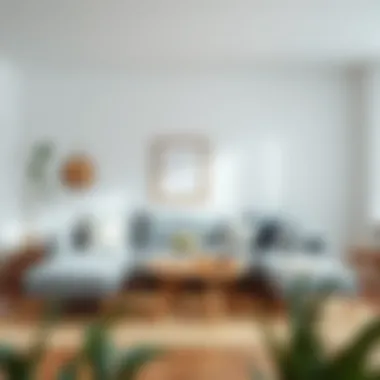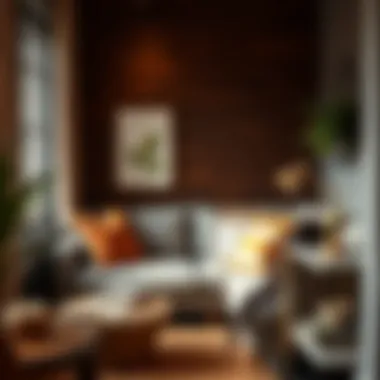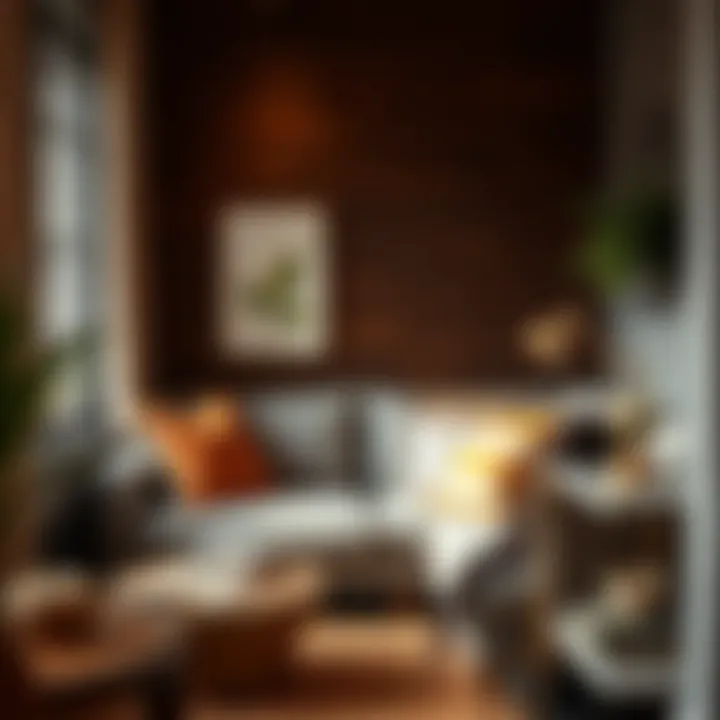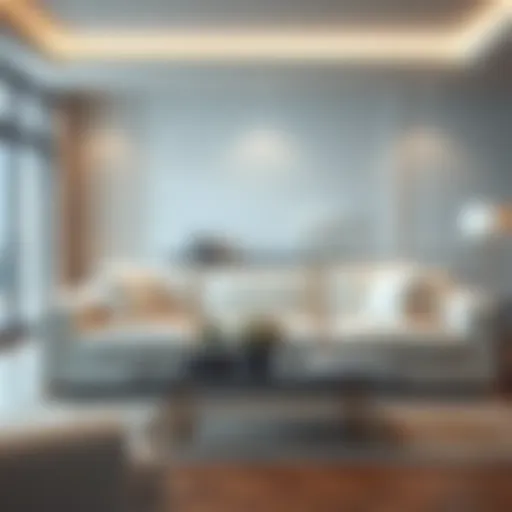Mastering Grey Sofa Decor: A Complete Guide


Intro
A grey sofa often stands as a cornerstone in modern interior design, blending well with a variety of styles while offering a canvas for creativity. Its neutral tone opens up possibilities; you can play around with colors, textures, and arrangements to create a space that feels both inviting and visually appealing. Whether it's nestled in a minimalistic room or thrown into an eclectic mix, a grey sofa has a versatility that many other colors simply can't match.
This article serves as a comprehensive guide for homeowners, designers, and DIY enthusiasts. We will explore furniture design trends that breathe life into living spaces, address essential considerations when purchasing a grey sofa, and recommend options for every budget. Designed with both aesthetics and functionality in mind, our guide emphasizes practical tips that will elevate your space.
Let's dive into the trends shaping today's interiors, from the ever-refreshing minimalist styles to the bold expressions of eclectic design. By the end, you'll have a thorough understanding of how to make your grey sofa not just a piece of furniture, but a captivating focal point of your home.
Understanding the Versatility of Grey Sofas
In the world of interior design, the grey sofa stands tall as a paragon of versatility. It invites homeowners and designers alike to explore its adaptability across various styles, ensuring a seamless incorporation into any space. The beauty of a grey sofa lies not merely in its hue but in its transformative power, allowing for the creation of vastly different atmospheres.
Neutral Foundation in Design
A grey sofa serves as a neutral foundation in design—an anchor point from which creativity can flourish. Being neutral, grey works harmoniously with a kaleidoscope of colors. Whether you lean towards vibrant yellows and blues or prefer soft pastels and earthy tones, grey blends effortlessly, making it an ideal choice for those who like to change things up. This adaptability allows homeowners to experiment with different accents and accessories without needing to swap out their foundational piece.
- Think of the grey sofa as a blank canvas. Paired with colorful cushions or bright artwork, it can bring a lively ambiance to a room.
- If you crave a calm environment, earthy tones like beige or greenery harmonize magnificently with grey, softening the whole aesthetic.
This capacity to shift and mold to the desired decor style empowers individuals to express their unique taste. If you’ve got a modern aesthetic, you can keep lines sleek and minimal. In a more traditional setup, adornments can sway toward ornate and classic designs, effortlessly maintaining cohesiveness throughout.
Emotional and Psychological Impact of Grey
The choice of color can evoke powerful emotional responses, and grey is no exception. Psychologically, grey is often associated with calmness and tranquility. It carries a quiet sophistication that can contribute to a peaceful environment. When choosing a grey sofa, it’s essential to consider how this color can impact mood and perception within a space.
- Subtle appeal: Grey embodies neutrality, allowing occupants to feel at ease. It’s neither too stimulating nor too dull.
- Promotes focus: In home offices or study areas, grey can assist in minimizing distractions, providing a more conducive environment for productivity.
However, it’s worth noting that all shades of grey are not created equal. Some might skew warm, while others can feel quite cool, influencing the emotions differently. Warm greys, infused with hints of beige or taupe, can create a welcoming sanctuary, while cooler greys often invoke a modern, chic sensibility.
"A grey sofa doesn’t just sit there; it stands as a silent mediator between color and form, bridging the gap in any design narrative."
Ultimately, understanding the emotional undertones of grey is crucial in designing a space that resonates with its inhabitants. So, whether it's a relaxing retreat or a lively hub for social gatherings, a grey sofa adapts not just in color but also in ambiance, making it a distinctive choice in interior spaces.
Choosing the Right Shade of Grey
Selecting the right shade of grey for your sofa is crucial, as it lays the groundwork for the entire room's aesthetic. Grey is a flexible color that can range from being cool and crisp to warm and inviting, depending on the tones involved. The impact of this choice resonates throughout your decorating journey, affecting everything from color schemes to light perception in your space. Understanding the nuances of grey tones can transform a room from mundane to magnificent.
When discussing shades of grey, it's vital to consider not just personal preference, but also the characteristics of the room. A light grey can amplify an airy feel in a small space, while a darker shade can create a cozy, enveloping atmosphere in more expansive areas. This section will delve into two significant factors: the undertones of grey and the influence of light and surrounding space.
Cool vs. Warm Undertones
To effectively choose the right grey, one must first grasp the concept of undertones. Grey can lean cooler with hints of blue or green, imparting a refreshing vibe. Alternatively, warm greys include glimpses of beige or brown, providing a homey, earthy feel. The choice between cool and warm undertones can sway the mood of your room significantly.
- Cool Grey: Perfect for spaces that aim for a chic, urban look. Think modern designs, where shades like Benjamin Moore’s "Stonington Grey" shine bright under natural light. It's often paired with other cool colors or crisp whites to enhance that contemporary edge.
- Warm Grey: Ideal for creating inviting spaces, especially in traditional or transitional homes. Colors such as Sherwin-Williams’ "Agreeable Grey" set a serene backdrop, marrying well with wooden elements or richer colors painted on walls.
In essence, align your grey selection with the furniture, artwork, and the overall vibe of your home. When in doubt, utilize swatches, as different lighting—artificial or natural—can alter how the shades emerge.
The Role of Light and Space
Light plays a monumental role in how grey surfaces look and feel. Grey sofas can adapt to their surroundings, but the light quality—whether warm or cool—directly influences this.
- Natural Light: A room bathed in sunlight typically makes cool greys pop and look livelier. In contrast, warm grey might feel more muted under bright conditions, leading to a calmer, more subdued environment.
- Artificial Light: The type of artificial lighting you use can also shift a grey's visual impact. Incandescent bulbs can warm up cool greys, while LED lights might sharpen the edges of warm grey, exposing their cooler characteristics.
- Space Perception: The shade of grey can also alter how you perceive dimensions. Lighter greys can make small spaces appear larger, while dark grey can create a cozy cocoon effect. Thus, one's choice should consider not only aesthetic but also spatial dynamics.
By being mindful of these elements, you're not just choosing a color; you are crafting an experience in your home. Make it count!
Complementary Color Schemes
When it comes to incorporating a grey sofa into your living space, understanding complementary color schemes is crucial. Grey is known for its flexibility, serving as a neutral backdrop on which you can layer a plethora of colors. This adaptability allows homeowners, designers, and DIY enthusiasts to explore various palettes that enhance both aesthetic appeal and functionality.


Narrating this journey begins with the recognition that color sets the mood of a space. While grey offers a calm, subdued vibe, the color combinations you choose can either elevate that tranquility or inject a vibrant energy into your rooms. Let’s break down the layers of interaction between grey and other colors.
Pairing with Bold Colors
Bold colors can act as a striking counterpoint to your grey sofa, adding excitement and drama to the room. Think of how a bright mustard yellow or a deep emerald green can pop against grey.
An important consideration here is balance; use bold hues sparingly to avoid overwhelming the space. A few accent pillows or a statement piece like a vivid piece of wall art can transform the atmosphere without losing the greyscale harmony.
Some suggested bold pairings include:
- Red: This can bring warmth and a sense of vibrancy, drawing the eye.
- Turquoise: Provides an unexpected freshness, making the room lively and inviting.
- Royal Blue: Adds sophistication alongside the neutrality of grey.
Incorporating these colors can turn a plain-looking room into a haven of bold designs.
Subtle and Earthy Tones
In contrast to the vibrancy of bold colors, subtle and earthy tones create a calming environment, promoting a serene atmosphere. Think taupes, muted greens, and soft browns that can complement the grey sofa beautifully. The goal here is to create a cohesive flow that lends itself to relaxation and comfort.
Consider incorporating the following earthy shades:
- Cream: Softens the overall palette and heightens the grey's softness.
- Sage: Offers a gentle touch without overpowering the grey, fostering a natural feel.
- Terracotta: This warm undertone can ground a space, making it feel cozy and inviting.
The beauty of using these tones lies in their ability to create layers without drawing too much attention away from the main pieces of furniture, like your grey sofa.
Monochromatic Approaches
Another compelling way to style a grey sofa is to embrace a monochromatic color scheme. Utilizing varying shades of grey, from charcoal to light silver can create depth and dimension while maintaining a sleek and sophisticated look.
To pull this off:
- Layer different textures, such as a chunky knitted throw over smooth upholstery to add visual interest.
- Introduce slight variations in the grey palette by including patterned cushions or decorative accents, which can break the monotony without stepping outside the color family.
Monochromatic designs are particularly favored in modern and minimalist settings because they create a streamlined, uncluttered appearance while still holding depth.
"A grey sofa is more than a mere sitting fixture; it's a canvas awaiting the colors of life to be brushed upon it."
By using complementary color schemes effectively, homeowners can achieve a stunning balance between the grey sofa and the space surrounding it. It’s about embracing the harmony that arises from contrast, while still minding the textures, patterns, and styles of the environment.
Selecting Textures and Fabrics
When it comes to decorating with a grey sofa, textures and fabrics become critical elements that can make or break the look of your entire living space. The right textures can add depth, interest, and a personal touch, transforming an ordinary sofa into a focal point of the room. Choosing the right fabric not only affects aesthetics but also impacts comfort and durability, making this a vital step in your decor journey.
Importance of Texture in Design
Texture plays a significant role in how we perceive a space. It can create warmth, softness, or a sense of formality depending on how it's integrated within the designs. For instance, pairing a grey sofa with a chunky knit throw or velvet cushions introduces a tactile dimension that invites people to relax and unwind.
In a visually stimulating room, incorporating a variety of textures avoid monotony and creates layers, allowing different elements to play off each other. Consider a mix of smooth cotton pillows with a coarse woven area rug and a polished wooden coffee table; when arranged well, these contrasting textures can produce a cohesive yet dynamic space.
"Texture is more than skin deep; it’s about how the different materials harmonize in your space."
Choosing Durable Fabrics
When selecting fabrics for upholstery, durability is a prime consideration. Grey sofas are versatile, suggesting they're often placed in high-traffic areas in homes. Materials like performance fabrics, which are engineered to resist stains and scratches, can be a game-changer. Fibers such as polyester blends and treated cottons provide longevity without sacrificing style.
Some recommended durable fabrics include:
- Microfiber: Soft and easy to clean, perfect for homes with kids and pets.
- Canvas: A robust option that comes in various colors and patterns, which can be ideal for a casual vibe.
- Leather: While often pricier, leather adds a sophisticated touch and, if maintained, can last a lifetime.
Opting for fabrics that are both stylish and resilient means you won't have to worry much about wear and tear over time, allowing you to enjoy the comfort of your grey sofa with less fuss.
Layering Textures for Depth


Layering different textures is an art form in interior design, especially around a grey sofa. It not only helps to enrich the visual complexity of the space, but it also enhances comfort levels. Start with a strong foundation by introducing larger elements; think a soft, textured blanket draped over one arm of the sofa.
Here are a few practical tips for creating layers:
- Mix and Match: Combine different fabric types like linen, cotton, and wool to achieve an inviting look.
- Use Accents: Incorporate ribbed or patterned cushions to break the solid look of the grey fabric.
- Vary the Sizes: Stack pillows of various shapes and dimensions to add interest while conveying a relaxed environment.
By carefully selecting and layering your textures, you create a multi-dimensional aesthetic that not only looks good but feels inviting. Emphasizing this aspect may result in a space that feels more alive and cohesive.
In summary, the textures and fabrics you choose play a pivotal role in complementing your grey sofa, enriching the ambience of your home, and reflecting your unique style.
Incorporating Patterns and Prints
In the realm of interior design, the choice of patterns and prints can truly elevate your space, especially when paired with a grey sofa. Integrating these elements adds depth and character, transforming what could be a plain setup into something visually engaging. Patterns can introduce a sense of movement and rhythm to a room, inviting the eye to linger and explore the details.
Moreover, the right patterns can break any monotony that a neutral sofa could potentially bring, creating a dynamic balance in your decor. When one considers the subtleties of patterns against a grey backdrop, the possibilities expand dramatically, ranging from playful florals to bold geometrics.
Ways to Use Patterns Effectively
Using patterns effectively requires a bit of finesse and thought. Here are some strategies to consider:
- Mix and Match: Combining different patterns can be tricky, but it’s the magic sauce. Ensure they complement each other, focusing on a similar color palette. For instance, pairing a striped throw pillow with a floral one can create an enticing contrast without clashing.
- Balance is Key: Introducing patterns in moderation keeps the room from feeling overwhelmed. A single patterned rug can work beautifully beneath your grey sofa, drawing attention without overshadowing it.
- Scale Matters: Consider the scale of your patterns. Large prints work well in spacious rooms, while smaller designs can enhance coziness in intimate settings.\n By keeping these points in mind, the effective usage of patterns can create a more cohesive and sophisticated design.
Complementary Prints for Dynamic Spaces
When aiming for a lively atmosphere, you’ll want to carefully select complementary prints that resonate well with your grey sofa. Here are a few suggestions:
- Floral and Botanical Prints: These can softens the hard edges of furniture and are great for adding life to the room. Try introducing cushions with a delicate floral pattern that carries hues found in your sofa.
- Geometric Designs: Sharp angles and structured forms can create a striking contrast against the gentle lines of your furniture. A geometric print in a throw blanket or artwork can invigorate space.
- Textured Patterns: Incorporating tactile patterns, like woven fabrics or embossed materials, adds another layer of dimension to the design. These work lovely on curtains or other fabric elements near your seating area.
Incorporating the right prints and patterns around your grey sofa can turn an ordinary space into an extraordinary one. Whether you choose to go bold or subtle, the key lies in creating a harmonious balance that enriches the overall aesthetic while keeping functionality front and center.
"Patterns tell a story in a home, wrapping the grey sofa in a narrative that evokes emotion and connection."
For more inspiration in decorating with patterns, check out this article on design choices, which dives deeper into color theory and spatial dynamics.
Styling Around the Grey Sofa
Incorporating a grey sofa into your living space can be an exhilarating adventure. However, the styling process does not end with the sofa itself. Styling "around" the grey sofa encompasses multiple elements that help create a well-thought-out living area. This section delves into the key components of designing a cohesive space, ensuring that the grey sofa not only serves as the centerpiece but also enhances the overall aesthetic. Key points to consider include the selection of accent chairs and tables, alongside the use of wall art and decor, which can bring your design vision to life.
Choosing Accent Chairs and Tables
Accent chairs and tables play pivotal roles in complementing a grey sofa. They don’t just fill up space; they define the character of the room. Choosing these elements wisely can elevate the décor from mundane to stunning.
- Size and Scale: The size of your accent chairs and tables should respect the proportions of the grey sofa. A bulky, overstuffed chair may overwhelm a sleek, modern sofa. Conversely, overly small pieces can make the seating arrangement look disproportionate.
- Material Matters: Mixing and matching materials can create an engaging visual appeal. A leather chair paired with a velvet sofa can introduce an interesting texture contrast that draws the eye. Similarly, wooden tables can ground the space while providing warmth.
- Color Coordination: Opt for colors that either complement or contrast the grey. If your sofa leans more towards a cool tone, consider using warm accent chairs — think rich burgundy or deep mustard. On the flip side, if the sofa has warmer shades, cooler accents can add depth.
Ultimately, the synergy between your sofa and the accents sets the mood for the entire room. Just remember to keep it fun yet functional.
Utilizing Wall Art and Decor
Wall art and decor are your secret weapons for breathing life into your space. Blank walls can feel hollow, making your grey sofa seem detached from the room. Art and decorative elements serve two main functions: enhancing aesthetic appeal and reflecting your personal style.
- Artwork Selection: When selecting art, aim for pieces that resonate with you but also match the vibe of the room. Large canvas prints can create a focal point above your sofa, while smaller pieces can line the walls to form a gallery-style arrangement. Mixing different art styles can also produce an eclectic feel that beautifully contrasts with the neutrality of grey.
- Decorative Accessories: Items such as cushions, throws, and statement vases should not be overlooked. They add layers and textures that break the monotony. Choosing decor items that incorporate colors from your accent chairs or tables can weave a cohesive story throughout the room.
- Functional Decor: Consider decorative elements that serve a purpose, like stylish bookshelves or unique side tables. They blend function with artistry, making your environment both practical and visually appealing.
"Remember, it’s about the small details. The right combination of accents and decor can transform a simple grey sofa into a statement piece!"
In wrapping up, thoughtfully selecting accent chairs and tables alongside art and decor can dramatically influence the ambiance of your space. This attention to detail creates a harmonious environment, ensuring that the grey sofa stands as a centerpiece, not an afterthought.
Considerations for Different Design Styles


When it comes to integrating a grey sofa into your interiors, understanding various design styles is vital. Each style brings its own unique flair, dictating how elements like color, texture, and space interact. Recognizing these nuances can help homeowners, designers, and DIY enthusiasts create that perfect atmosphere—all while highlighting the sofa's versatility. The grey sofa stands out either as a bold statement or a seamless background, depending on your chosen style. Let's explore these styles in detail.
Modern and Minimalist Design
In modern and minimalist spaces, less is often more. A grey sofa fits right in with this philosophy. Its muted tones offer a clean backdrop that invites simplicity and clarity. This design approach is less about fuss and frills and more about functionality and elegance. Here are a few key points to bear in mind:
- Clean Lines: The design of your grey sofa should favor sleek, geometric shapes. Avoid ornate details that can clutter the clean aesthetic.
- Color Palette: Stick to whites, blacks, and other neutral shades to maintain harmony. Occasional splashes of color through accessories can also enliven the space without overwhelming it.
- Furniture Arrangement: Position the grey sofa in a way that emphasizes the open space. For instance, floating sofas away from walls can encourage conversation, maintaining that open feel that defines modern and minimalist designs.
A grey sofa isn't just a piece of furniture; it's a statement about lifestyle and values. Its understated nature can encourage mindfulness and simplicity in your living environment.
Transitional Design Elements
Transitional design blends traditional and contemporary styles, creating spaces that feel timeless and comfortable. The grey sofa can act as a bridge between these eras, allowing you to play with both aesthetics. Consider these aspects:
- Textural Diversity: Combine fabrics like leather and cotton with the grey sofa to add warmth and character. This mix can evoke a feeling of familiarity while commonly found in more traditional settings.
- Accent Pieces: Integrate wooden elements alongside the sofa. Pairing it with a reclaimed wood coffee table or vintage armchair introduces a charming contrast without deviating from the grey tone.
- Layered Lighting: Using warm, soft lighting can enhance the cozy atmosphere that transitional designs often aim for. A well-placed floor lamp next to your grey sofa could create an inviting reading nook.
In transitional settings, balance is the key. By using the grey sofa as a central, neutral point, you can create a space that embodies both comfort and sophistication.
Eclectic Decor Strategies
The eclectic decor style is all about personal expression, mixing and matching different elements to convey your unique personality. Here, a grey sofa serves as a fantastic foundation. Here are some thoughts to consider:
- Bold Accessories: Use vibrant cushions and mismatched throws on your grey sofa. This can draw the eye while keeping the overall appearance grounded. Think deep reds or bright yellows; they contrast beautifully against grey.
- Layering Artworks: Fill the walls with various art pieces, from classic paintings to modern prints. A grey sofa allows these artworks to shine, as it doesn’t overshadow them.
- Contrasting Textures: Play with various materials. Combine a plush grey sofa with metal or glass coffee tables, or even a rattan chair, to create a tactile variety that feels lively.
The beauty of eclectic design lies in its freedom and spontaneity. Using a grey sofa as your blank canvas, you can splash on quoted colors, shapes, and textures that define you.
A grey sofa is not just furniture—it's a focal point, a cushion for conversation, and a foundation for the adventurous decorator's imagination.
Practical Maintenance of a Grey Sofa
Maintaining a grey sofa is not merely about sustaining its appearance; it plays a key role in preserving the comfort and longevity of the furniture. Grey sofas, with their sleek and neutral tones, can easily become the focal point of a room. However, neglecting proper maintenance can lead to premature wear, stains, and diminished appeal. For homeowners, designers, and DIY enthusiasts, understanding the practical maintenance techniques can ensure that your grey sofa remains a centerpiece of comfort and style in your living space.
Cleaning Techniques for Various Fabrics
When it comes to cleaning a grey sofa, the first step is recognizing the material of your upholstery. Different fabrics require specific care methods to keep them in prime condition. Below are some common types of upholstery and effective cleaning methods tailored to them:
- Leather: For a leather grey sofa, you’ll want to use a mild soap mixed with water. A damp cloth can be used to wipe down surfaces without soaking the material. Finish up with a good leather conditioner to keep the material supple and avoid cracks.
- Microfiber: Microfiber sofas are known for their durability and ease of cleaning. A simple mixture of distilled water and white vinegar can work wonders. Use a clean cloth, and dab the solution onto the stains rather than rubbing them, which could spread the stain.
- Textiles like Linen or Cotton: For these materials, a steam cleaner can be very effective. If you have removable covers, washing them according to the label instructions usually yields the best results.
"Regularly attend to your grey sofa's upkeep; what appears minor can snowball into a larger problem if you let it slide."
In addition, routine vacuuming is essential. Vacuuming at least once a week removes dust, pet hair, and crumbs that can cause grimy buildup or allergens. Using a brush attachment is usually most effective; this way, you can reach crevices that often hoard debris.
Preventing Wear and Tear
The best offense is a good defense, as they say. When it comes to maintaining a grey sofa, preventing wear and tear is crucial for extending its life. Here are some strategies to consider:
- Positioning: Avoid placing your sofa in direct sunlight as UV rays can fade colors and weaken the fabric. It's wise to place it away from windows or use window coverings to block harsh sunlight.
- Cushion Fluffing: Make it a habit to fluff your cushions regularly. This helps maintain their shape and prevents sagging, keeping the sofa looking new.
- Protective Covers: Consider using a throw or sofa cover when not in use. This not only protects from dust but keeps it safe from spills by acting as a barrier against stains.
- Rotation: If your sofa has removable cushions, rotating them helps in wearing evenly, preventing unevenness that can detract from the sofa's aesthetics.
- Pet Management: If you have pets, it’s crucial to train them to stay off the furniture or at least provide them with their own designated area. There are also various pet-safe sprays available that discourage pets from jumping on sofas.
Ultimately, maintaining your grey sofa is an ongoing commitment. By understanding the cleaning requirements and implementing preventive strategies, you can ensure that your piece remains stylish and functional for years to come.
Culmination: Crafting a Cohesive Look
In design, it’s not just about placing furniture in a room; it’s about harmonizing elements to create a space that speaks to the soul. The grey sofa is often the unsung hero in many living rooms, commanding attention without overshadowing other elements. It serves as a visual anchor, leading you through color palettes and textures that create a truly inviting atmosphere. A well-thought-out design surrounding the grey sofa allows homeowners to explore creativity while ensuring functionality and comfort. This is particularly essential in an age where personal style meets practicality.
When crafting a cohesive look, consider how each piece of decor—be it a coffee table, wall art, or even the choice of curtains—interacts with the grey sofa. Here are some essential aspects to ponder:
- Color Harmony: Adjust the surrounding colors to either complement or contrast with the grey. Each shade influences mood and perception. A muted palette can evoke calm, while vibrant colors can inspire energy.
- Texture Variation: Layering different textures, from a plush throw blanket to a wicker basket, adds depth and interest. The interplay between textures makes the space dynamic.
- Personal Touches: Incorporate personal elements that reflect your journey; art pieces, family photos, or unique finds add character to the living room.
- Functionality Consideration: Think about the room’s purpose. A family gathering spot may require a cozy setting with ample seating, while a minimalist style may focus on clear lines and space.
"The art of decoration lies in the balance of harmony and contrast."
Given the versatility of grey, it’s crucial to align your choice of supplementary elements around this neutral foundation. Whether you want a modern touch or a rustic vibe, the journey of integrating a grey sofa involves understanding its place within a broader design narrative. By focusing on these key areas, you not only create a cohesive look but also craft a space that narrates a story, inviting, warm, and deeply personal.
Final Thoughts on Grey Sofa Integration
When integrating a grey sofa into your living space, remember that it’s more than just a piece of furniture; it’s a statement of your style. By embracing the myriad of colors, textures, and styles that can complement it, you craft an environment that resonates with who you are. In the end, a grey sofa is like the backbone of your interior, supporting the aesthetic structure while allowing creativity to flow. Keep experimenting, learn from each adjustment, and most importantly, enjoy the process of transforming your living space into a reflection of your distinct taste.















